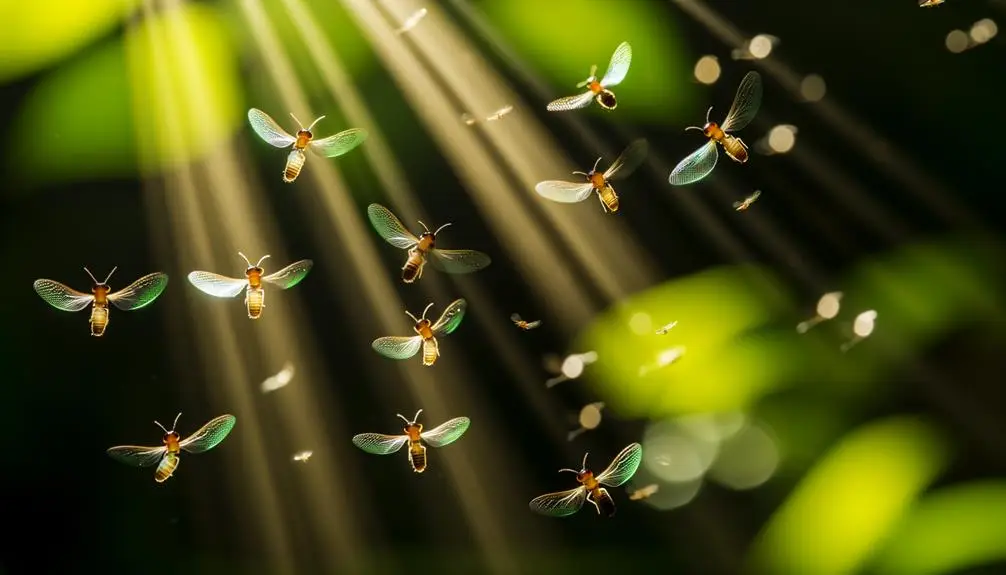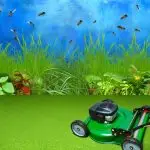Yes, termites can fly! During their reproductive swarming phase, they leave their colonies in search of mates and new homes. These flying termites are often called “swarmers” or “alates.” You may spot them on warm evenings when conditions are just right. They differ from ants in appearance and behavior. While they can fly, it’s typically short-lived as they quickly settle to mate and establish colonies. Understanding their swarming habits and how to identify them can help you manage potential infestations effectively. If you’re curious about how to prevent them, you might want to keep going for more insights!
Do Termites Fly?
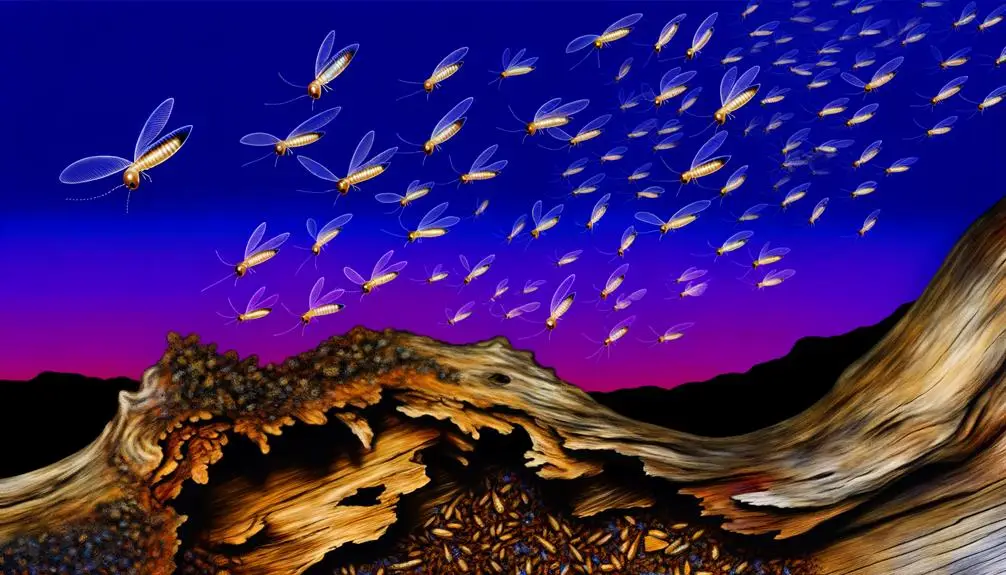
Termites can indeed fly, but only a specific group known as alates. These remarkable insects, often called swarmers, are the winged, sexually mature termites that leave their colonies to commence nuptial flights. It’s during these flights that alates mate, a vital step in establishing new colonies. You might notice these flying termites most often during warm, humid conditions, especially after heavy rainfall, when they take to the skies in search of partners. Their emergence can indicate potential infestations, making it essential to monitor and manage termite activity, as outlined in holistic pest management strategies.
What sets alates apart from other termites is their unique structure. Unlike workers and soldiers, they possess wings and have straight antennae, distinguishing them clearly from ants. After mating, they’ll shed their wings, symbolizing the start of their journey to create new colonies. It’s fascinating to think about how these flying termites shift from the sky to the ground, laying the foundation for a new life cycle.
Understanding the flying capabilities of alates helps you appreciate their role in the termite world. So next time you spot these swarmers, remember their journey toward mating and the establishment of new colonies, contributing to the thriving ecosystem around you.
Swarming Behavior of Termites
During specific times of the year, you might observe a fascinating phenomenon known as swarming, where alates, the winged reproductive termites, take to the skies in large numbers. This spectacular emergence signals the beginning of a new chapter for these swarmers, as they leave their original colony in search of mates and opportunities to establish new colonies. Swarming behavior can vary by species, with some, like the Formosan Subterranean Termite, known for their aggressive nature and rapid reproduction, making their swarming particularly concerning for homeowners. Swarming typically occurs on warm, humid days, often after rainfall, creating the perfect conditions for flying. As these termites take flight, they’re not just showcasing their wings; they’re also performing a critical function in their life cycle. The swarmers spread out, seeking to pair up and find suitable locations to start anew.
However, witnessing this beautiful event can also raise concerns about potential infestations in your home. If you’re seeing large groups of flying termites nearby, it’s essential to evaluate treatment options to safeguard your space. Understanding the importance of termite control can empower you to take action and guarantee your home remains a secure haven from unwanted guests. Embrace this knowledge, and you’ll feel more connected to the natural world around you.
Identifying Flying Termites
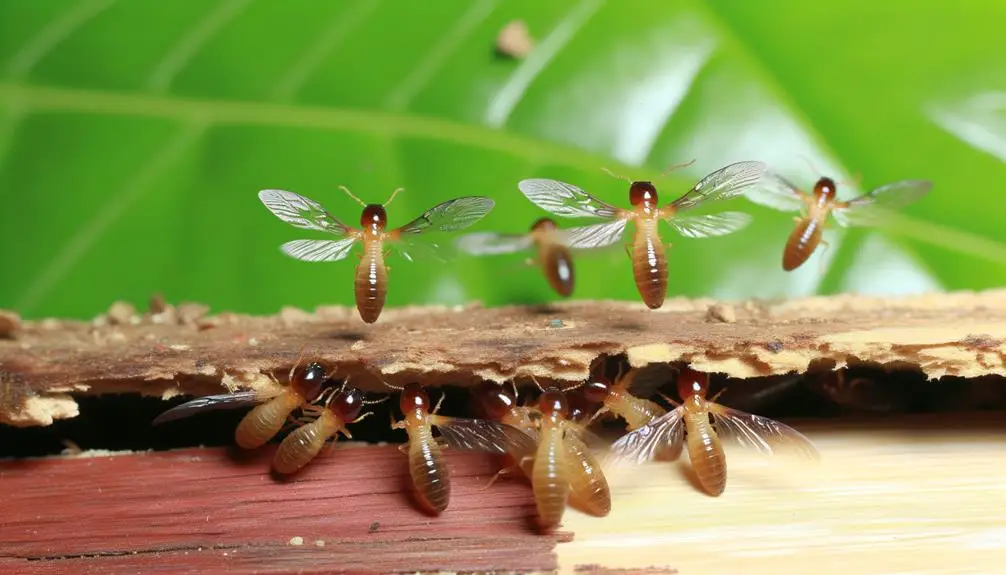
Flying termites, also known as alates, can be easily mistaken for other flying insects, which makes identification important for homeowners. Knowing how to identify these winged termites can help you take action before they cause damage.
| Characteristic | Flying Termites (Alates) | Other Flying Insects |
|---|---|---|
| Wings | Two pairs of wings | Varying wing structures |
| Body Shape | Thick waist, straight body | Slim or curved bodies |
| Color | Light brown to black | Various colors |
| Shed Wings | Shed wings near nests | Rarely shed wings |
| Behavior | Swarm in large groups | Less frequent swarming |
If you spot swarms of alates around your home, it’s a sign you may have a termite problem. Look closely for shed wings, as this can confirm their presence. Early identification can save you from costly pest control measures down the line. Remember, if you suspect flying termites, it’s essential to act quickly to prevent potential damage to your home. Trust your instincts and seek professional help if needed, ensuring your home stays protected and secure from these pests.
Conditions for Swarming
Swarming is a significant phase in the life cycle of flying termites, and it typically occurs under specific environmental conditions. You’ll notice that these swarms often happen during warm, humid temperatures, particularly in spring or summer. These ideal conditions trigger winged termites to leave their existing termite colonies to initiate a new journey.
As the temperature rises and humidity increases, the reproductive stage of these termites is activated. It’s fascinating to see how they take flight, searching for a suitable location to establish new colonies. This moment is essential for the survival and expansion of the species, but it can also lead to significant damage to your home if swarming occurs nearby.
When you spot flying termites, it’s important to understand that they’re not just wandering aimlessly; they’re on a mission to find a place to thrive. Recognizing the conditions for swarming can help you take proactive measures to protect your property. By being aware of these signs, you can join a community of homeowners who share tips and strategies to prevent infestations and ensure their homes from the potential havoc these pests can wreak. These winged invaders are particularly active in warm, humid climates, making flying termites in South Florida a common concern for homeowners. Taking early action, such as reducing excess moisture and sealing potential entry points, can greatly minimize the risk of an infestation. Staying informed and vigilant will help you protect your home from costly termite damage.
Differences Between Termites and Ants
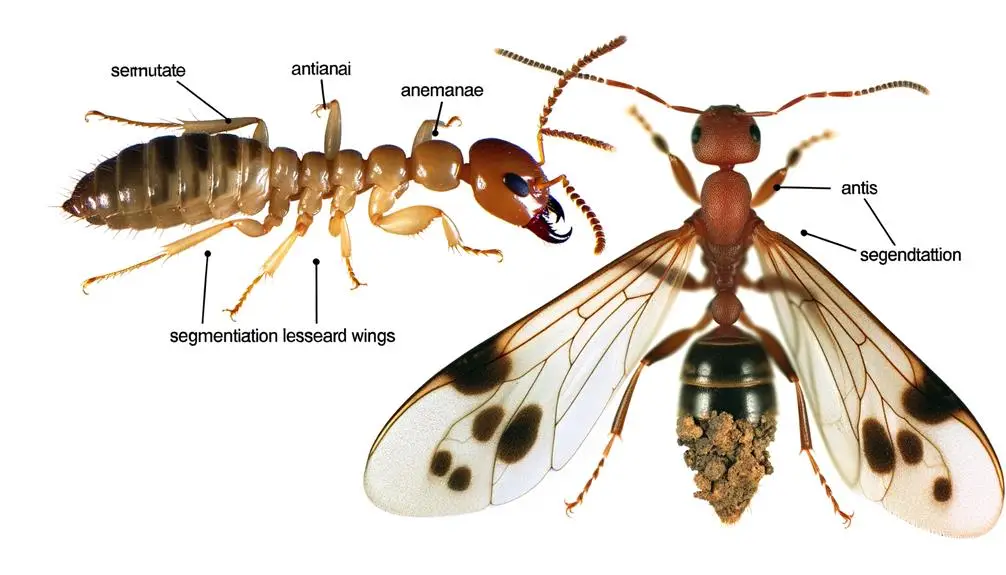
When you look closely at termites and ants, you’ll notice some key differences in their physical appearance, behaviors, and wing structures. Termites often have straight, beaded antennae and a more uniform body shape, while ants typically have elbowed antennae and a distinct waist. Understanding these distinctions can help you identify which pest you’re dealing with.
Physical Appearance Differences
Distinguishing between termites and ants can be tricky, especially since both insects share similar habitats. However, their physical appearance reveals key differences that can help you identify them. When you spot winged termites, also known as alates or swarmers, you’ll notice they have straight antennae and a broad waist. In contrast, flying ants have bent antennae and a narrower, pinched waist. Understanding these differences is vital, as termite infestations can lead to significant structural damage, and effective pest control solutions are essential for prevention.
Another noticeable difference is in their wings. Winged termites have two pairs of wings that are of equal length, while flying ants have front wings that are larger than their back wings. After swarming, both insects shed their wings, but you’ll often find the shed wings of termites clustered together, signaling a potential termite problem nearby.
Being able to spot these physical differences can empower you to take action. If you suspect a termite infestation, it’s wise to consult a control expert who can provide guidance tailored to the termite species in your area. Understanding these distinctions not only helps you feel more knowledgeable but also fosters a sense of belonging to a community that values home protection and awareness.
Behavior and Swarming Patterns
Understanding the behavior and swarming patterns of termites and ants is essential for effective pest management. When it comes to flying termites, you’ll notice specific swarming patterns that set them apart from their ant counterparts. Termite swarms usually occur during warm, humid evenings, especially after rain, as winged termites, or alates, emerge from their colony to mate and establish new colonies.
Reproductive termites are the stars of these swarms, and their presence is often a serious warning sign of potential termite infestations in your area. Unlike ants, which tend to swarm in a more erratic manner, termite swarms are more synchronized and often attracted to light sources. This attraction can lead them into homes, making it essential to recognize these winged termites when you see them.
While both ants and termites can create chaos in your space, knowing these differences in behavior can help you take swift action. If you spot a termite swarm, don’t ignore it—addressing it promptly can save you from extensive damage down the line. Staying informed about these patterns creates a stronger community for everyone facing similar challenges.
Wing Structure Comparison
How can you tell the difference between the wings of termites and ants? When you spot winged termites, also known as alates, you’ll notice some distinct features. Termite wings are all about symmetry; they have two pairs of wings that are the same size and shape. This uniformity is a telltale sign of these social insects. In contrast, ants have front wings that are larger than their hind wings, giving them an uneven appearance.
During swarming season, you might see flying termites shed their wings after mating, leaving behind a pile of shed wings. This behavior is quite different from ants, which typically don’t shed their wings. Understanding these differences is essential for effective pest control. Identifying termite colonies early can help prevent extensive termite damage to your home.
Impacts of Flying Termites
Flying termites can cause significant structural damage if left unchecked, so it’s essential to recognize the signs of an infestation early. You’ll want to understand how to spot these warning signs and implement effective control and prevention strategies. Let’s explore the impacts of flying termites and what you can do to protect your home.
Structural Damage Potential
The presence of flying termites can lead to significant structural damage in homes and buildings. When termite swarmers take to the skies, they’re searching for new places to establish colonies. If they find your home, it could mean trouble. Termite infestations often begin unnoticed, as these pests are experts at hiding their activity. Once inside, worker termites start tearing into wood, compromising the structure over time.
As you might know, existing colonies can cause extensive damage before you even realize what’s happening. Their feeding habits create hidden vulnerabilities, leading to costly repairs. You may spot signs like termite droppings, which indicate a thriving colony nearby. This is a call to action! It’s essential to stay proactive.
That’s where professional pest control comes in. They can provide a free termite inspection to assess your property and identify potential threats. Ignoring these flying termites can lead to significant damage, so don’t wait until it’s too late. By understanding the risks associated with termite life, you’ll be better equipped to protect your home and keep your loved ones secure from these destructive pests.
Infestation Warning Signs
Spotting flying termites can be a clear signal that an infestation is imminent. These winged termites are often mistaken for winged ants, but recognizing the difference is vital. If you see them swarming near your home, it’s a serious infestation warning sign. These pests can compromise the integrity of your property, leading to significant damage if left unchecked.
Termite colonies produce flying termites to establish new nests, which means more termite workers will soon follow. If you notice discarded wings around windows or doors, that’s another red flag. It indicates that termites are actively trying to establish themselves in your home.
To protect your space, you should quickly contact a pest control specialist. They can help you identify winged termites and assess the situation. Early intervention is key to preventing further damage. Remember, termite nests can be hidden from view, making it imperative to stay vigilant. If you see these warning signs, don’t wait—act fast. Your home deserves protection, and you have the power to guarantee it stays secure from these destructive insects. Stay informed, and you’ll create a sense of belonging in a termite-free environment.
Control and Prevention Strategies
When you come across flying termites, it’s essential to take action quickly to mitigate their impact. These pests can easily form colonies and cause significant damage to your home if left unchecked. Start by identifying the signs of swarming, as this usually indicates an established infestation nearby. Look for discarded wings and droppings, which signal that treatment is necessary.
Prevention is your best defense. Seal any cracks and crevices in your home’s foundation and walls to keep termites out. Regularly inspect wooden structures and guarantee proper drainage around your property to deter these pests. If you suspect an infestation, don’t hesitate to contact pest control professionals who specialize in termite treatment. They can offer tailored solutions to eliminate the problem effectively. Additionally, consider using termite-resistant building materials if you’re planning renovations, as this can help minimize the risk of future infestations. Implementing renovation termite prevention tips, such as treating wood with protective coatings and maintaining adequate ventilation, can further safeguard your home. Taking these proactive measures will ensure a stronger defense against termites and help protect your property in the long run. Regular maintenance and monitoring are key to detecting any early signs of termite activity before significant damage occurs. Investing in professional crawl space termite treatment can be particularly beneficial, as this area is highly susceptible to infestations due to moisture and wood-to-soil contact. By staying vigilant and proactive, you can effectively reduce the likelihood of costly termite damage and maintain the integrity of your home. In addition to regular inspections, scheduling periodic professional evaluations can help identify hidden infestations before they escalate. Investing in crawl space termite treatment ensures that vulnerable areas are adequately protected, reducing the chances of structural damage. Prioritizing these preventive steps will give you peace of mind and help maintain the long-term value of your home.
Consider using bait systems and liquid treatments to control existing colonies, as these methods target the heart of the infestation. Remember, it’s always better to act swiftly rather than deal with extensive damage later on. By staying proactive, you can protect your home from flying termites and foster a pest-free environment for you and your family.
Prevention and Control Methods
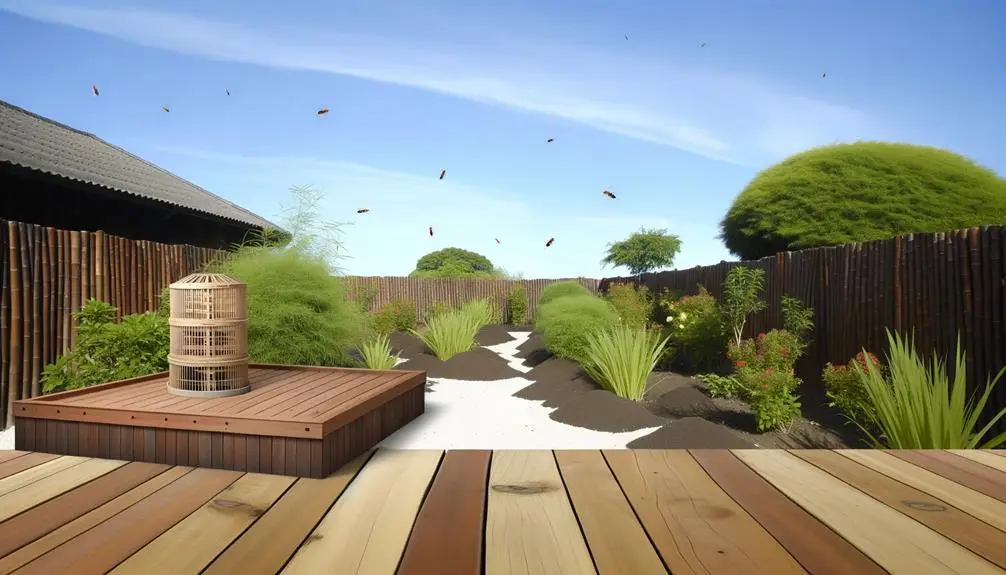
Effective prevention and control methods are essential for managing termite infestations. By staying proactive, you can protect your home from these destructive pests. Start by working with local pros who can help you create a thorough treatment plan tailored to your specific needs. Additionally, consider using pre construction termite services if you are building a new home, as they can help prevent infestations before they start. Regular inspections and ongoing maintenance are also crucial in ensuring that termites do not become a threat to your property. By combining professional assistance with preventive measures, you can effectively safeguard your home from costly termite damage. Seal any cracks or crevices in your home’s foundation and walls to reduce potential entry points for termites. If you suspect an infestation in your attic, consider a drywood termite attic treatment to eliminate hidden colonies before they cause significant damage. Regular inspections and timely interventions will help maintain a termite-free home. Another effective strategy is to use drywood termite spot treatment for targeted elimination of localized infestations, preventing further damage without the need for extensive fumigation. Combining this approach with moisture control and proper ventilation can make your home less attractive to termites. By staying vigilant and addressing issues promptly, you can ensure long-term protection against these persistent pests. In addition to these measures, maintaining a clutter-free environment and removing any decaying wood around your property can further reduce the risk of infestation. If termites are detected early, a drywood termite spot treatment can be an effective and less invasive solution to eliminate the problem before it spreads. Taking a comprehensive approach that includes regular monitoring and prompt action will help keep your home safe from termite damage for years to come. Additionally, combining chemical treatments with natural deterrents like orange oil can enhance your home’s defense against termites. If an infestation is localized, opting for a drywood termite spot treatment allows for precise elimination without the need for extensive fumigation. By integrating these targeted solutions with routine inspections, you can maintain a proactive approach to termite prevention and safeguard your property from long-term damage.
Here are some key strategies to take into account:
- Regular inspections: Have pest experts inspect your property regularly to identify winged termites and signs of activity.
- Moisture control: Keep your home dry. Fix leaks and guarantee proper drainage to reduce the moisture that attracts termites.
- Remove wood debris: Clear away any wood piles, old stumps, or shed wings from your yard to minimize potential nesting sites.
- Barrier treatments: Think about using chemical or physical barriers to prevent termites from entering your home.
Frequently Asked Questions
Can Termites Fly Around Your House?
Yes, termites can fly around your house, especially during swarm season. Knowing their behavior helps with damage assessment and pest control. Identifying species and understanding their lifecycle stages can aid in effective home prevention strategies.
Should I Worry About Winged Termites?
You might notice winged termites swarming around your home. It’s essential to identify them, as they can indicate termite colonies nearby. Understanding their seasonal patterns helps with prevention methods and pest control to avoid home damage. Seeing flying termites in South Florida is common during the warm, humid months, especially after rainfall. These swarmers are reproductive termites looking to establish new colonies, which can pose a threat to wooden structures. Taking immediate action by contacting a pest control professional can help prevent costly damage to your home. Implementing preventative measures, such as regular inspections and moisture control, can reduce the risk of an infestation. One effective solution is installing subterranean termite baiting stations, which target termite colonies and help prevent structural damage. Monitoring these stations consistently ensures early detection and increases the chances of protecting your home from costly repairs. Another effective approach for managing an infestation is utilizing no tent termite treatment, which eliminates termites without the need for large-scale tent fumigation. This method is less disruptive to homeowners while still effectively targeting termites within affected areas. Combining multiple treatment strategies with professional pest control services ensures long-term protection for your home. Regular maintenance and early intervention play key roles in keeping termite populations under control. Homeowners in South Florida can benefit from no tent termite treatment, which provides a convenient and effective way to eliminate termites without vacating the property. Consulting with a pest control expert ensures a customized approach that addresses the specific needs of your home while preventing future infestations.
Is a Flying Termite Dead?
A flying termite isn’t dead; it’s part of its seasonal activity. During swarming, these termites seek mates and establish colonies. Understanding their flight patterns helps identify potential damage signs and effective pest control methods. You’re not alone in this!
Can Flying Termites Bite You?
Flying termites can bite, but it’s rare. Their behavior focuses on reproduction during swarming seasons. Identifying them helps with control strategies, dispelling myths about their risks, and understanding colony dynamics and life cycles enhances security.
If You See Flying Termites Call A Professional
While flying termites can seem like a nuisance, their swarming behavior signifies both a new colony’s birth and the potential threat to your home. Recognizing the differences between termites and ants can help you respond effectively, turning chaos into control. By understanding their habits and implementing preventive measures, you can protect your space from these airborne invaders. Embrace this knowledge, and you’ll transform anxiety into action, ensuring your home remains protected and secure. Call us NaturePest today and schedule a free termite inspection.

